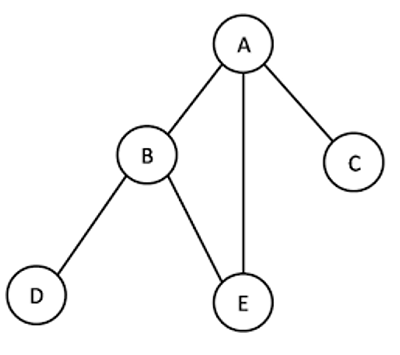Home »
Python »
Python Programs
Breadth First Search for a Graph in Python
Python | Breadth First Search: In this tutorial, we will learn about the breadth first search algorithm and its implement for a graph in Python.
By Soumya Sinha Last updated : April 21, 2023
A Breadth-first search algorithm is often used for traversing/searching a tree/graph data structure.
Here, we will learn to implement BFS Algorithm for a graph.
BFS Algorithm for a Graph
BFS for a graph is almost similar to BFS of a tree. There is only one difference here, unlike trees graphs may contain cycles, so it may happen that we come across the same vertex again and again. A vertex needs to be processed only once, so to avoid this situation we will use an array to keep track of the state of the vertex.
For example, in the following graph, suppose we start traversing from vertex A. When we come to vertex B, we look for all adjacent vertices of it. A is also an adjacent vertex of B. If we don't keep track of the visited vertices, then A will be processed again and again, hence this will become a non-terminating process.

Description
In this algorithm we need to discover vertices in order of distance from the source vertex. This breadth first search algorithm works for both directed and undirected graphs.
Data Structures Used
- state[u]: Provides the colour status of a node during the BFS operation.
- If state[u] = 1, then the node has not been discovered yet.
- If state[u] = 0, then the node has been discovered but not processed yet.
- If state[u] = 0, then the node has been processed.
- distance[u]: Stores the distance of a vertex from the source vertex S
- parent[u]: Stores the parent information
Procedure for BFS Algorithm for a Graph
The procedure of BFS algorithm for a graph is as follow,
BFS(G, s)
#Initialize all the vertex except the source vertex
#V[graph] – list of nodes in the graph
for each vertex u ε V [Graph] - {s}
do state[u] = 1
distance[u] = 'inf'
parent[u] = nil
#Initialize the source vertex
state[s] = 0
distance[s] = 0
parent[s] = nil
#Create an empty Queue and an array arr to store the result
queue = []
arr = []
#Insert the source vertex in the queue
Enqueue(queue, s)
#loop until queue is empty
while queue
do u 🡨 Dequeue(queue)
for each v ε Adjacent[u]
do if state[v] = 1
then state[v] = 0
distance[v] = distance[u]+1
parent[v] = u
Enqueue(queue, v)
state[u] = -1
Time Complexity
Time Complexity of BFS = O(V+E) where V is number of vertices and E is number of edges.
Python program to implement breadth first search for a graph
import sys
import math
def bfs(n, edges, s):
#initialize state, distance and parent for all the vertices
state = [0 for i in range(n)]
distance = [float('inf') for i in range(n)]
parent = [-1 for i in range(n)]
#initialize state, distance and parent for the source vertex
state[s] = 1
distance[s] = 0
parent[s] = 'NIL'
queue = []
arr = []
queue.append(s)
#Start discovering the vertices starting from the source vertex
while queue:
x = queue.pop(0)
arr.append(x)
#Start discovering the vertices adjacent to x and store
#information about their parent, distance and state
for i in range(len(edges[x])):
if state[edges[x][i]] == 0:
state[edges[x][i]] = 1
distance[edges[x][i]] = distance[x] + 1
parent[edges[x][i]] = x
queue.append(edges[x][i])
state[x] = -1
return arr
def main():
#input format is described below
n, m, s = map(int, input().split())
edges = {}
for i in range(n):
edges[i] = []
for i in range(m):
a, b = map(int, input().split())
edges[a] += [b]
edges[b] += [a]
for i in range(n):
edges[i].sort()
arr = bfs(n, edges, s)
print(*arr)
if __name__ == '__main__':
main()
Input
Input format:
- First line of input contains the integers n, m s where
- n = number of nodes
- m = number of edges
- s = source node
- Next m lines contain two integers which specifies that the vertices are connected by an edge
9 13 0
0 1
0 7
1 7
1 2
2 3
2 5
2 8
3 4
3 5
4 5
5 6
6 7
7 8
Output
Output Format: Breadth first traversal starting from source node
0 1 7 2 6 8 3 5 4
Python Data Structure Programs »
Advertisement
Advertisement